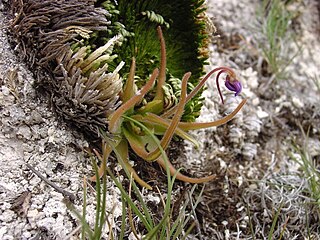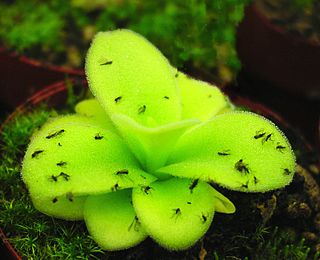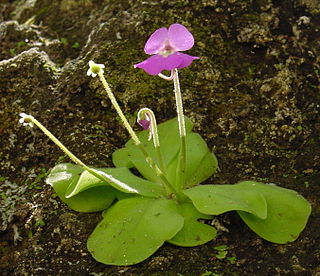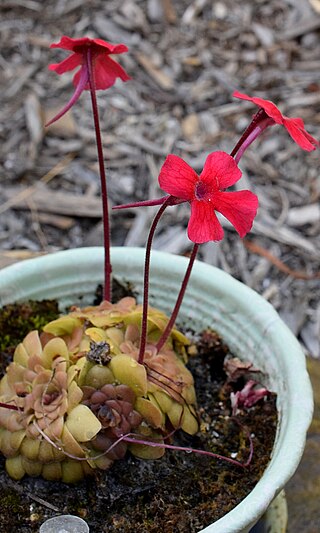
Pinguicula moranensis is a perennial rosette-forming insectivorous herb in the flowering plant family Lentibulariaceae. It is native to El Salvador, Guatemala, Honduras and Mexico. A species of butterwort, it forms summer rosettes of flat, succulent leaves up to 10 centimeters (4 in) long, which are covered in mucilaginous (sticky) glands that attract, trap, and digest arthropod prey. Nutrients derived from the prey are used to supplement the nutrient-poor substrate that the plant grows in. In the winter the plant forms a non-carnivorous rosette of small, fleshy leaves that conserves energy while food and moisture supplies are low. Single pink, purple, or violet flowers appear twice a year on upright stalks up to 25 centimeters long.

Pinguicula laxifolia is an insectivorous plant of the genus Pinguicula native to the Mexican state of Tamaulipas, the only member of the section Orchidioides. Its pendulous leaves are unusual in the genus, which features mostly species with stiff or succulent leaves.

Pinguicula gypsicola is an insectivorous plant of the genus Pinguicula native to the Mexican state of San Luis Potosi, a heterophyllous member of the section Orcheosanthus. It grows in gypsum soils and forms stemless rosettes of upright, narrow leaves.

Pinguicula alpina, also known as the alpine butterwort, is a species of carnivorous plant native to high latitudes and altitudes throughout Eurasia. It is one of the most widespread Pinguicula species, being found in mountainous regions from Iceland to the Himalayas. Native to cold climates, it is a temperate species, forming prostrate rosettes of green to red leaves and white flowers in the summer and a tight hibernaculum during a period of winter dormancy in the winter. Like all members of the genus, P. alpina uses mucilaginous glands covering the surface of its summer leaves to attract, trap, and digest arthropod prey.

Pinguicula gigantea is a tropical species of carnivorous plant in the family Lentibulariaceae. Its native range is within Mexico. P. gigantea's flower is usually a purple colour with the occasional light blue also seen. P. gigantea was once classified as Pinguicula ayautla.

Pinguicula ramosa is a species of butterwort, a carnivorous plant, endemic to the mountains of Nikkō National Park in Japan. It belongs to the section micranthus and is closely related to Pinguicula variegata. It is unique in the genus for having a forked flower stalk.

Pinguicula acuminata is an insectivorous plant of the genus Pinguicula endemic to the Mexican state of Hidalgo, a member of the section Heterophyllum. It is notable for producing flowers while the winter rosette is buried beneath the soil surface. Described in 1839, it was not rediscovered until 150 years later.

Pinguicula longifolia, commonly known as the long-leaved butterwort, is a perennial carnivorous subalpine plant of the Central Pyrenees, found on both sides of the border. It catches its prey by using its modified leaves that lie on the ground and have “densely covered stalked glands that bear a droplet of sticky mucilage on its top.” The need to capture arthropods is driven by the lack of nutrients present in the soil. P. l. subsp. longifolia obtain their nutrition primarily from flying insects, mainly diptera, which replenished the carnivorous plant with nitrogen. P. l. subsp. longifolia grows in wet shady areas and on vertical or overhanging limestone walls. It has been found at altitudes between 700 – 1900 meters. In the spring, the winter buds open and the first carnivorous leaves present themselves. These leaves are then followed by the flowers in early summer. Throughout summer the leaves can grow up to 14 cm in length and have glands present on both sides of the leaves, which is highly characteristic of P. l. subsp. longifolia. More carnivorous leaves arise throughout summer, and when the conditions become unfavourable, around autumn, a protective winter casing composed of scale like leaves is produced, in the centre of the rosette, called the hibernacula, also known as the plant bud. The leaves halt production and the old leaves wither and decay; P. l. subsp. longifolia is now ready for the winter dormancy. There must be optimal growth during the summer for P. l. subsp. longifolia, otherwise they produce weakened hibernacula which rot very easily.

Pinguicula orchidioides is a perennial rosette-forming insectivorous herb native to Mexico and Guatemala. A species of butterwort, it forms summer rosettes of flat, succulent leaves up to 5 centimeters (2 in) long, which are covered in mucilaginous (sticky) glands that attract, trap, and digest arthropod prey. Nutrients derived from the prey are used to supplement the nutrient-poor substrate that the plant grows in. Uniquely among Pinguicula species from the Americas, p. orchidioides produces gemma-like basal buds which elongate into stolons and serve as a means of asexual reproduction. In the winter the plant forms a non-carnivorous rosette of small, fleshy leaves that conserves energy while food and moisture supplies are low. Single purple flowers appear between July and September on upright stalks up to 22 centimeters long.

Pinguicula elizabethiae is a perennial rosette-forming insectivorous herb native to the Mexican states of Querétaro and Hidalgo. A species of butterwort, it forms summer rosettes of flat, succulent leaves up to 5 centimeters (4 in) long, which are covered in mucilaginous (sticky) glands that attract, trap, and digest arthropod prey. Nutrients derived from the prey are used to supplement the nutrient-poor substrate that the plant grows in. In the winter the plant forms a non-carnivorous rosette of small, fleshy leaves that conserves energy while food and moisture supplies are low. Single purple flowers appear between July and October on upright stalks up to 75 millimeters long.

Pinguicula, commonly known as butterworts, is a genus of carnivorous flowering plants in the family Lentibulariaceae. They use sticky, glandular leaves to lure, trap, and digest insects in order to supplement the poor mineral nutrition they obtain from the environment. Of the roughly 80 currently known species, 13 are native to Europe, 9 to North America, and some to northern Asia. The largest number of species is in South and Central America.

Pinguicula lutea, commonly known as the yellow butterwort, is a species of warm-temperate carnivorous plant in the family Lentibulariaceae. It grows in savannas and sandy bog areas of the Southeastern United States.

Cassiano Conzatti, aka Cassiano Bartolameotti-Conzatti, was a botanist, botanical explorer and pteridologist, and director of the Oaxaca Botanical Garden in Mexico. Conzatti lived and worked in Mexico for the greater part of his life and was an early authority on the flora of Oaxaca.

Pinguicula filifolia, is a carnivorous species of plant found predominantly in western Cuba and some of the neighboring regions. It was discovered by Charles Wright in 1866. It is a tropical plant that uses sticky secretions on its leaves to catch small insects, pollen, and other plant debris to help supplement its own nutrition. It thrives in swamp like white sand savannahs with high temperatures and humidity.

Pinguicula macroceras, the California butterwort or horned butterwort, is a species of perennial carnivorous herb that is native to the North American Pacific coast, as well as other select distributions in Canada, Russia, Japan, and the United States.[3] [7] Common names include California butterwort, horned butterwort and butterwort. Pinguicula macroceras belongs to the genus Pinguicula and the family Lentibulariaceae.

The North American continent is home to a wide variety of carnivorous plant species. Species from seven genera are native to the continent, and three of these genera are found nowhere else on the planet.

Pinguicula pumila, commonly known as the small butterwort or dwarf butterwort is a small species of carnivorous plant in the genus Pinguicula. It is native to the southeastern United States, where it grows in habitats where soil is poor in nutrition.

Pinguicula cyclosecta is a perennial rosette-forming insectivorous plant native to the state of Nuevo León in Mexico.

Pinguicula lueana is a perennial rosette-forming insectivorous plant native to the state of Oaxaca in Mexico. It is the only species of butterwort known to have a red flower. As Pinguicula lauana it has gained the Royal Horticultural Society's Award of Garden Merit.
Pinguicula hemiepiphytica is a tropical carnivorous plant species native to the cloud forests of Oaxaca, Mexico. It was first identified in 1991 and is one of the few epiphytic species in the genus.




















